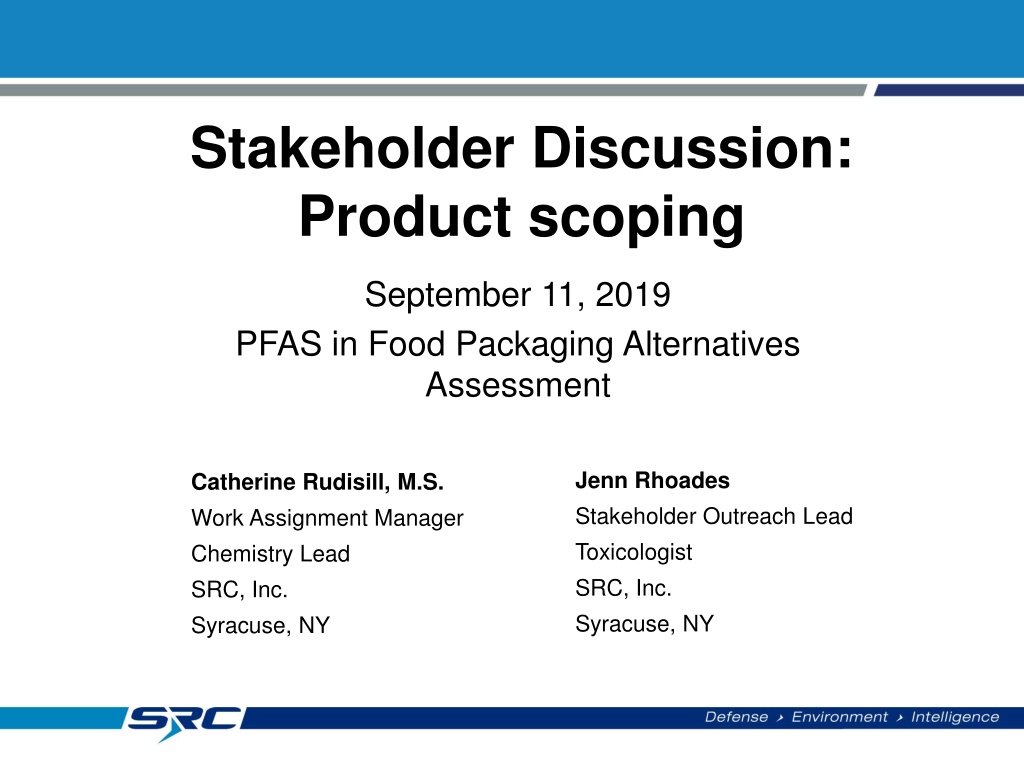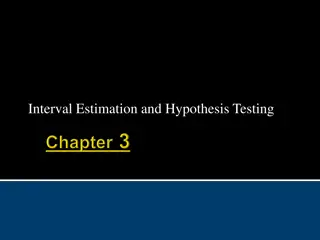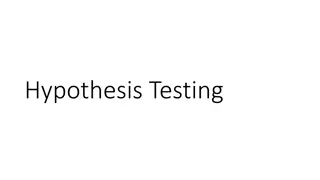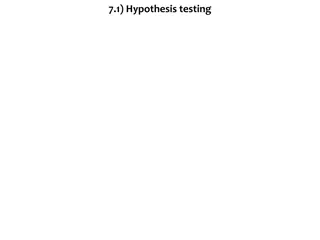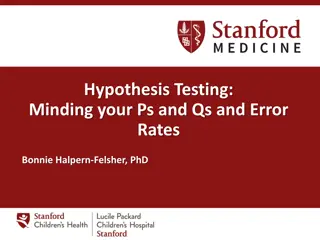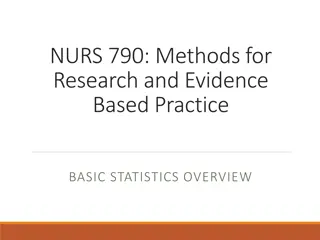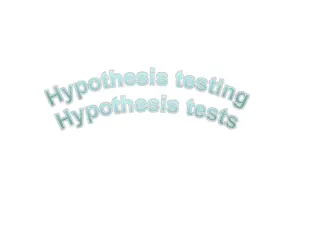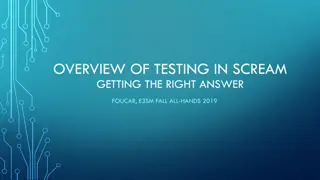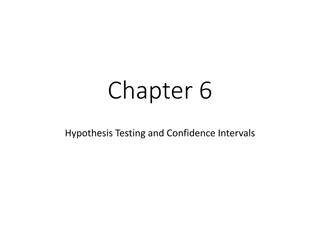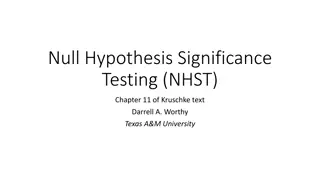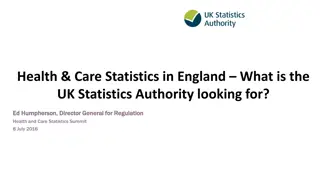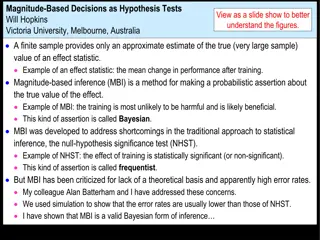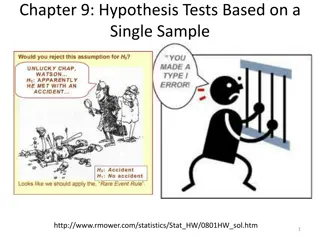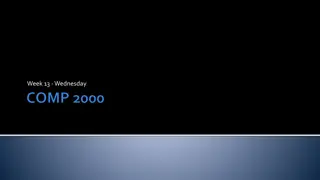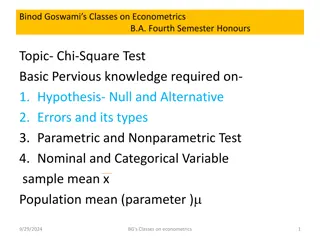Visualization Basics and Statistics Hypothesis Testing
This content covers topics on Visualization basics, statistics basics, exploring penguins dataset, scatter plots replication, merging plots, hypothesis testing, and more. It discusses concepts like null hypothesis, alternative hypothesis, p-values, significance levels, and standard deviation. Explore how penguins of different species look using scatter plots, and understand the likelihood of observations under null hypothesis. Dive into creating basic plots with ggplot, understanding variance in normal distribution, and terms like p-value, alpha level, and mean hypothesis.
Download Presentation

Please find below an Image/Link to download the presentation.
The content on the website is provided AS IS for your information and personal use only. It may not be sold, licensed, or shared on other websites without obtaining consent from the author.If you encounter any issues during the download, it is possible that the publisher has removed the file from their server.
You are allowed to download the files provided on this website for personal or commercial use, subject to the condition that they are used lawfully. All files are the property of their respective owners.
The content on the website is provided AS IS for your information and personal use only. It may not be sold, licensed, or shared on other websites without obtaining consent from the author.
E N D
Presentation Transcript
Stakeholder Discussion: Product scoping September 11, 2019 PFAS in Food Packaging Alternatives Assessment Jenn Rhoades Stakeholder Outreach Lead Toxicologist SRC, Inc. Syracuse, NY Catherine Rudisill, M.S. Work Assignment Manager Chemistry Lead SRC, Inc. Syracuse, NY PR 18-####
Overview Ground rules for the call 5 mins - Brief background and overview 5 mins - Results of survey 45 mins - Follow-up Discussion Close out PR 18-####
Project Overview WA State Law RCW 70.95G Bans perfluorinated and polyfluorinated substances from food packaging materials Food package" means a package or packaging component that is intended for direct food contact and is comprised, in substantial part, of paper, paperboard, or other materials originally derived from plant fibers. Perfluoroalkyl and polyfluoroalkyl substances" or "PFAS chemicals" means, for the purposes of food packaging, a class of fluorinated organic chemicals containing at least one fully fluorinated carbon atom. Dept of Ecology will conduct an Alternatives Assessment that considers: Chemical hazard Exposure Performance Cost & availability If Ecology determines that there are sufficient alternatives based on this assessment, then ban will take effect "If the department of ecology does not find that a safer alternative is available for some or all categories of food packaging applications, beginning January 1, 2021, and each year following, the department of ecology must review and report on alternatives " PR 18-####
Project Overview PFAS CAP website link: https://www.ezview.wa.gov/?alias=1962&pageid=37105 Alternatives Assessment for PFAS in Food Packaging Stakeholder Webinar #1 (May 15, 2019) https://www.ezview.wa.gov/Portals/_1962/Documents/PFAS/PFAS%20AA%20 Webinar_05152019.pdf Ecology is developing a website dedicated solely to the PFAS in Food Packaging AA that will be separate from the current PFAS CAP Online Scoping Survey Released July 1, 2019 Distributed to all stakeholder via PFAS CAP list-serve and direct email. Responses accepted through July 31st (extended to allow for additional responses) PR 18-####
Scoping Survey Response Stakeholder Representation 4 State and local government 3 Trade Groups (chemical, packing, hospitality) 5 NGO 5 Chemical manufacturer 3 Product manufacturer 3 Paper/ fiber based products producer 1 Supplier 1 Purchaser (grocer) 2 Other PR 18-####
Ground Rules Follow the time limits for each portion for discussion Keep discussion focused on product scoping Participants will be unmuted during the discussion portions Please announce yourself and affiliation before speaking Hold off on follow-ups or rebuttals until everyone has had a chance to speak This call will NOT be recorded Follow-up discussions individually, as needed PR 18-####
Discussion: Market Sectors (10 mins) Major take-homes: 1. There are packaging applications that overlap between market sectors. 2. Difficult to scope solely on market sector, although it is helpful in understanding impact. Questions: To what extent does market sector (ie. QSR) apply to the concept of specific application ? Are there any additional clarifications or concerns from the stakeholder group on this topic? PR 18-####
Discussion: Molded Fibers (15 mins) Major take-homes: 1. Clear majority stated that there are limited options for non-PFAS alternatives 2. Products are in development 3. There is a distinction between products using wet-end additives and those using a barrier coating Questions: Are there coated alternatives on the market that do not contain PFAS? Any other points of clarification or concerns on molded fiber applications? PR 18-####
Tentative Scoping Strategy (20 mins) Based on scoping survey and independent research: The most appropriate perspective would be to limit specific packaging applications rather than by market sector or by material. Paper wraps and liners constitute a significant portion (~10%; $945 million) of the foodservice single-use packaging demand (Freedonia, 2017), and appears to have an established set of alternatives. Bags (paper and plastic) constitute an additional 9% of market demand ($825 million; 32.3 billion units) (Freedonia, 2017). The scope of alternatives for paper wraps and liners is a manageable size in the context of the current timeline and budget. PR 18-####
Scoping to Paper Liners, Wraps, etc. Barrier Coating Alternatives Base Material Alternatives Wax Mechanically-densified paper Clay Aluminum foil PLA Foil-lined paper PET PVC cling film PVOH copolymers Insulated paper Silicon Questions: 1. What is your feedback on potentially limiting product scope to paper liners and wraps? 2. Does it make sense to include bags and sleeves? Does the technology overlap between product types 3. Are there other relevant alternatives not mentioned here? PR 18-####
Scoping Survey Response Non-scoping responses to be addressed in the future: Adoption of alternatives to molded fibers (coatings) may require process redesigns on the manufacturing side Consumer education and awareness will help drive the change to PFAS- free alternatives. What is the true need for OGR properties for products? Is it a perceived convenience? Concern for price competitiveness and availability for alternatives PR 18-####
Close-Out Will review comments from this discussion and release slides from this call to the full stakeholder group with the September update. Aim to have finalized list of potential alternatives by the end of September. Hazard and Exposure Methodology and Decision Rules will be released for stakeholder comment by the end of September. This will help inform stakeholders on what types of data are needed and how the data will be evaluated. October 2019 Start discussions on Performance Module Cathy Rudisill rudisill@srcinc.com Jenn Rhoades rhoades@srcinc.com Thank you! PR 18-####
